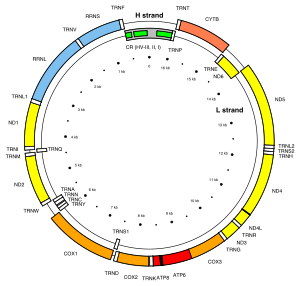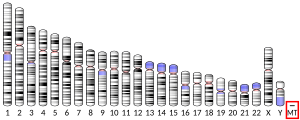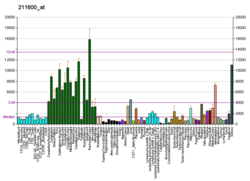MT-ND4 is a gene of the mitochondrial genome coding for the NADH-ubiquinone oxidoreductase chain 4 (ND4) protein.[5] The ND4 protein is a subunit of NADH dehydrogenase (ubiquinone), which is located in the mitochondrial inner membrane and is the largest of the five complexes of the electron transport chain.[6] Variations in the MT-ND4 gene are associated with age-related macular degeneration (AMD), Leber's hereditary optic neuropathy (LHON), mesial temporal lobe epilepsy (MTLE) and cystic fibrosis.[7][8][9][10]
| ND4 | |||||||||||||||||||||||||||||||||||||||||||||||||||
|---|---|---|---|---|---|---|---|---|---|---|---|---|---|---|---|---|---|---|---|---|---|---|---|---|---|---|---|---|---|---|---|---|---|---|---|---|---|---|---|---|---|---|---|---|---|---|---|---|---|---|---|
| Identifiers | |||||||||||||||||||||||||||||||||||||||||||||||||||
| Aliases | ND4, MTMT-NADH dehydrogenase, subunit 4 (complex I), NADH dehydrogenase subunit 4 | ||||||||||||||||||||||||||||||||||||||||||||||||||
| External IDs | OMIM: 516003; MGI: 102498; HomoloGene: 38240; GeneCards: ND4; OMA:ND4 - orthologs | ||||||||||||||||||||||||||||||||||||||||||||||||||
| |||||||||||||||||||||||||||||||||||||||||||||||||||
| |||||||||||||||||||||||||||||||||||||||||||||||||||
| |||||||||||||||||||||||||||||||||||||||||||||||||||
| |||||||||||||||||||||||||||||||||||||||||||||||||||
| Wikidata | |||||||||||||||||||||||||||||||||||||||||||||||||||
| |||||||||||||||||||||||||||||||||||||||||||||||||||

Structure
editThe MT-ND4 gene is located in human mitochondrial DNA from base pair 10,760 to 12,137.[5][11] The MT-ND4 gene produces a 52 kDa protein composed of 459 amino acids.[12][13] MT-ND4 is one of seven mitochondrial genes encoding subunits of the enzyme NADH dehydrogenase (ubiquinone), together with MT-ND1, MT-ND2, MT-ND3, MT-ND4L, MT-ND5, and MT-ND6. Also known as Complex I, this enzyme is the largest of the respiratory complexes. The structure is L-shaped with a long, hydrophobic transmembrane domain and a hydrophilic domain for the peripheral arm that includes all the known redox centres and the NADH binding site. MT-ND4 and the rest of the mitochondrially encoded subunits are the most hydrophobic of the subunits of Complex I and form the core of the transmembrane region.[6]
An unusual feature of the human MT-ND4 gene is the 7-nucleotide gene overlap of its first three codons (5'-ATG CTA AAA-3' coding for amino acids Met-Leu-Lys) with the last three codons of the MT-ND4L gene (5'-CAA TGC TAA-3' coding for Gln, Cys and Stop).[11] With respect to the MT-ND4L reading frame (+1), the MT-ND4 gene starts in the +3 reading frame: [CAA][TGC][TAA]AA versus CA[ATG][CTA][AAA].
Function
editMT-ND4 is a subunit of the respiratory chain Complex I that is believed to belong to the minimal assembly of core proteins required to catalyze NADH dehydrogenation and electron transfer to ubiquinone (coenzyme Q10).[14] Initially, NADH binds to Complex I and transfers two electrons to the isoalloxazine ring of the flavin mononucleotide (FMN) prosthetic arm to form FMNH2. The electrons are transferred through a series of iron-sulfur (Fe-S) clusters in the prosthetic arm and finally to coenzyme Q10 (CoQ), which is reduced to ubiquinol (CoQH2). The flow of electrons changes the redox state of the protein, resulting in a conformational change and pK shift of the ionizable side chain, which pumps four hydrogen ions out of the mitochondrial matrix.[6]
Studies in cystic fibrosis cases suggest that MT-ND4 expression is indirectly upregulated by the cystic fibrosis transmembrane conductance regulator (CFTR) channel chloride transport activity. Channel flow double-electrode (CFDE) cells ectopically expressing wild-type CFTR channels were used to test the effect of CFTR chloride transport inhibitors glibenclamide and CFTR(inh)172 and demonstrated a reduction in MT-ND4 expression.[7]
Clinical significance
editMT-ND4 contains one of five mitochondrial single-nucleotide polymorphisms (SNPs) associated with age-related macular degeneration (AMD) in Mexican Americans, mt12007.[10]
Leber's hereditary optic neuropathy (LHON) correlates with a mutation in the MT-ND4 gene in multiple families. The mutation at codon 340 results in the elimination of an Sfa NI site by the conversion of a highly conserved arginine to a histidine. This provides a simple diagnostic test by which to identify LHON, a maternally inherited disease that results in optic nerve degeneration and cardiac dysrythmia.[9]
Amino acid changes in MT-ND4, MT-ND5 and MT-ATP8 resulting from mutations at the 11994, 8502 and 13,231 bp of mtDNA are significantly correlated in mesial temporal lobe epilepsy (MTLE) patients with hippocampal sclerosis. The 11994 C>T mutation to the MT-ND4 gene results in a Thr to Ile shift at the 412 position. Genome analysis has never been used in MTLE cases and could provide another diagnostic method in the disease.[8]
MT-ND4 is downregulated in cystic fibrosis, a disease that results from mutations in the cystic fibrosis transmembrane conductance regulator (CFTR) channel.[7]
Interactions
editMT-ND4 has been shown to have 21 binary protein-protein interactions including 15 co-complex interactions. MT-ND4 appears to interact with SP1, ZNF16, CTCF, GRB2, and ATM.[15]
References
edit- ^ a b c GRCh38: Ensembl release 89: ENSG00000198886 – Ensembl, May 2017
- ^ a b c GRCm38: Ensembl release 89: ENSMUSG00000064363 – Ensembl, May 2017
- ^ "Human PubMed Reference:". National Center for Biotechnology Information, U.S. National Library of Medicine.
- ^ "Mouse PubMed Reference:". National Center for Biotechnology Information, U.S. National Library of Medicine.
- ^ a b "Entrez Gene: MT-ND4 mitochondrially encoded NADH dehydrogenase 4".
- ^ a b c Pratt, Donald Voet, Judith G. Voet, Charlotte W. (2013). "18". Fundamentals of biochemistry : life at the molecular level (4th ed.). Hoboken, NJ: Wiley. pp. 581–620. ISBN 9780470547847.
{{cite book}}: CS1 maint: multiple names: authors list (link) - ^ a b c Valdivieso AG, Marcucci F, Taminelli G, Guerrico AG, Alvarez S, Teiber ML, Dankert MA, Santa-Coloma TA (May 2007). "The expression of the mitochondrial gene MT-ND4 is downregulated in cystic fibrosis". Biochemical and Biophysical Research Communications. 356 (3): 805–9. doi:10.1016/j.bbrc.2007.03.057. PMID 17382898.
- ^ a b Gurses C, Azakli H, Alptekin A, Cakiris A, Abaci N, Arikan M, Kursun O, Gokyigit A, Ustek D (April 2014). "Mitochondrial DNA profiling via genomic analysis in mesial temporal lobe epilepsy patients with hippocampal sclerosis". Gene. 538 (2): 323–7. doi:10.1016/j.gene.2014.01.030. PMID 24440288.
- ^ a b Wallace DC, Singh G, Lott MT, Hodge JA, Schurr TG, Lezza AM, Elsas LJ, Nikoskelainen EK (December 1988). "Mitochondrial DNA mutation associated with Leber's hereditary optic neuropathy". Science. 242 (4884): 1427–30. Bibcode:1988Sci...242.1427W. doi:10.1126/science.3201231. PMID 3201231.
- ^ a b Restrepo NA, Mitchell SL, Goodloe RJ, Murdock DG, Haines JL, Crawford DC (2015). "Mitochondrial variation and the risk of age-related macular degeneration across diverse populations". Pacific Symposium on Biocomputing. Pacific Symposium on Biocomputing: 243–54. PMC 4299880. PMID 25592585.
- ^ a b Homo sapiens mitochondrion, complete genome. "Revised Cambridge Reference Sequence (rCRS): accession NC_012920", National Center for Biotechnology Information. Retrieved on 30 January 2016.
- ^ Zong NC, Li H, Li H, Lam MP, Jimenez RC, Kim CS, Deng N, Kim AK, Choi JH, Zelaya I, Liem D, Meyer D, Odeberg J, Fang C, Lu HJ, Xu T, Weiss J, Duan H, Uhlen M, Yates JR, Apweiler R, Ge J, Hermjakob H, Ping P (October 2013). "Integration of cardiac proteome biology and medicine by a specialized knowledgebase". Circulation Research. 113 (9): 1043–53. doi:10.1161/CIRCRESAHA.113.301151. PMC 4076475. PMID 23965338.
- ^ "NADH-ubiquinone oxidoreductase chain 4". Cardiac Organellar Protein Atlas Knowledgebase (COPaKB).
- ^ "MT-ND4 - NADH-ubiquinone oxidoreductase chain 4 - Homo sapiens (Human)". UniProt.org: a hub for protein information. The UniProt Consortium.
- ^ "21 binary interactions found for search term MT-ND4". IntAct Molecular Interaction Database. EMBL-EBI. Retrieved 2018-08-25.
Further reading
edit- Andreu AL, Tanji K, Bruno C, Hadjigeorgiou GM, Sue CM, Jay C, Ohnishi T, Shanske S, Bonilla E, DiMauro S (June 1999). "Exercise intolerance due to a nonsense mutation in the mtDNA ND4 gene". Annals of Neurology. 45 (6): 820–3. doi:10.1002/1531-8249(199906)45:6<820::aid-ana22>3.0.co;2-w. PMID 10360780. S2CID 21203395.
- Torroni A, Achilli A, Macaulay V, Richards M, Bandelt HJ (June 2006). "Harvesting the fruit of the human mtDNA tree". Trends in Genetics. 22 (6): 339–45. doi:10.1016/j.tig.2006.04.001. PMID 16678300.
- Lertrit P, Noer AS, Jean-Francois MJ, Kapsa R, Dennett X, Thyagarajan D, Lethlean K, Byrne E, Marzuki S (September 1992). "A new disease-related mutation for mitochondrial encephalopathy lactic acidosis and strokelike episodes (MELAS) syndrome affects the ND4 subunit of the respiratory complex I". American Journal of Human Genetics. 51 (3): 457–68. PMC 1682709. PMID 1323207.
- Lu X, Walker T, MacManus JP, Seligy VL (July 1992). "Differentiation of HT-29 human colonic adenocarcinoma cells correlates with increased expression of mitochondrial RNA: effects of trehalose on cell growth and maturation". Cancer Research. 52 (13): 3718–25. PMID 1377597.
- Marzuki S, Noer AS, Lertrit P, Thyagarajan D, Kapsa R, Utthanaphol P, Byrne E (December 1991). "Normal variants of human mitochondrial DNA and translation products: the building of a reference data base". Human Genetics. 88 (2): 139–45. doi:10.1007/bf00206061. PMID 1757091. S2CID 28048453.
- Majander A, Huoponen K, Savontaus ML, Nikoskelainen E, Wikström M (November 1991). "Electron transfer properties of NADH:ubiquinone reductase in the ND1/3460 and the ND4/11778 mutations of the Leber hereditary optic neuroretinopathy (LHON)". FEBS Letters. 292 (1–2): 289–92. doi:10.1016/0014-5793(91)80886-8. PMID 1959619. S2CID 26368887.
- Kormann BA, Schuster H, Berninger TA, Leo-Kottler B (November 1991). "Detection of the G to A mitochondrial DNA mutation at position 11778 in German families with Leber's hereditary optic neuropathy". Human Genetics. 88 (1): 98–100. doi:10.1007/BF00204937. PMID 1959931. S2CID 23163944.
- Moraes CT, Andreetta F, Bonilla E, Shanske S, DiMauro S, Schon EA (March 1991). "Replication-competent human mitochondrial DNA lacking the heavy-strand promoter region". Molecular and Cellular Biology. 11 (3): 1631–7. doi:10.1128/MCB.11.3.1631. PMC 369459. PMID 1996112.
- Wallace DC, Singh G, Lott MT, Hodge JA, Schurr TG, Lezza AM, Elsas LJ, Nikoskelainen EK (December 1988). "Mitochondrial DNA mutation associated with Leber's hereditary optic neuropathy". Science. 242 (4884): 1427–30. Bibcode:1988Sci...242.1427W. doi:10.1126/science.3201231. PMID 3201231.
- Chomyn A, Cleeter MW, Ragan CI, Riley M, Doolittle RF, Attardi G (October 1986). "URF6, last unidentified reading frame of human mtDNA, codes for an NADH dehydrogenase subunit". Science. 234 (4776): 614–8. Bibcode:1986Sci...234..614C. doi:10.1126/science.3764430. PMID 3764430.
- Chomyn A, Mariottini P, Cleeter MW, Ragan CI, Matsuno-Yagi A, Hatefi Y, Doolittle RF, Attardi G (1985). "Six unidentified reading frames of human mitochondrial DNA encode components of the respiratory-chain NADH dehydrogenase". Nature. 314 (6012): 592–7. Bibcode:1985Natur.314..592C. doi:10.1038/314592a0. PMID 3921850. S2CID 32964006.
- Brown WM, Prager EM, Wang A, Wilson AC (1982). "Mitochondrial DNA sequences of primates: tempo and mode of evolution". Journal of Molecular Evolution. 18 (4): 225–39. Bibcode:1982JMolE..18..225B. doi:10.1007/BF01734101. hdl:2027.42/48036. PMID 6284948. S2CID 10908431.
- Anderson S, Bankier AT, Barrell BG, de Bruijn MH, Coulson AR, Drouin J, Eperon IC, Nierlich DP, Roe BA, Sanger F, Schreier PH, Smith AJ, Staden R, Young IG (April 1981). "Sequence and organization of the human mitochondrial genome". Nature. 290 (5806): 457–65. Bibcode:1981Natur.290..457A. doi:10.1038/290457a0. PMID 7219534. S2CID 4355527.
- Montoya J, Ojala D, Attardi G (April 1981). "Distinctive features of the 5'-terminal sequences of the human mitochondrial mRNAs". Nature. 290 (5806): 465–70. Bibcode:1981Natur.290..465M. doi:10.1038/290465a0. PMID 7219535. S2CID 4358928.
- De Vries DD, Went LN, Bruyn GW, Scholte HR, Hofstra RM, Bolhuis PA, van Oost BA (April 1996). "Genetic and biochemical impairment of mitochondrial complex I activity in a family with Leber hereditary optic neuropathy and hereditary spastic dystonia". American Journal of Human Genetics. 58 (4): 703–11. PMC 1914692. PMID 8644732.
- Sudoyo H, Sitepu M, Malik S, Poesponegoro HD, Marzuki S (1999). "Leber's hereditary optic neuropathy in Indonesia: two families with the mtDNA 11778G>A and 14484T>C mutations". Human Mutation. Suppl 1: S271-4. doi:10.1002/humu.1380110186. PMID 9452107. S2CID 35198022.
- Andrews RM, Kubacka I, Chinnery PF, Lightowlers RN, Turnbull DM, Howell N (October 1999). "Reanalysis and revision of the Cambridge reference sequence for human mitochondrial DNA". Nature Genetics. 23 (2): 147. doi:10.1038/13779. PMID 10508508. S2CID 32212178.
- Ingman M, Kaessmann H, Pääbo S, Gyllensten U (December 2000). "Mitochondrial genome variation and the origin of modern humans". Nature. 408 (6813): 708–13. Bibcode:2000Natur.408..708I. doi:10.1038/35047064. PMID 11130070. S2CID 52850476.
- Finnilä S, Lehtonen MS, Majamaa K (June 2001). "Phylogenetic network for European mtDNA". American Journal of Human Genetics. 68 (6): 1475–84. doi:10.1086/320591. PMC 1226134. PMID 11349229.
- Maca-Meyer N, González AM, Larruga JM, Flores C, Cabrera VM (2003). "Major genomic mitochondrial lineages delineate early human expansions". BMC Genetics. 2: 13. doi:10.1186/1471-2156-2-13. PMC 55343. PMID 11553319.
- Herrnstadt C, Elson JL, Fahy E, Preston G, Turnbull DM, Anderson C, Ghosh SS, Olefsky JM, Beal MF, Davis RE, Howell N (May 2002). "Reduced-median-network analysis of complete mitochondrial DNA coding-region sequences for the major African, Asian, and European haplogroups". American Journal of Human Genetics. 70 (5): 1152–71. doi:10.1086/339933. PMC 447592. PMID 11938495.
External links
edit- Mass spectrometry characterization of MT-ND4 at COPaKB
- Thorburn DR, Rahman S (1993–2015). "Mitochondrial DNA-Associated Leigh Syndrome and NARP". In Pagon RA, Adam MP, Ardinger HH, Wallace SE, Amemiya A, Bean LJ, Bird TD, Dolan CR, Fong CT, Smith RJ, Stephens K (eds.). GeneReviews [Internet]. Seattle (WA): University of Washington, Seattle. PMID 20301352.


